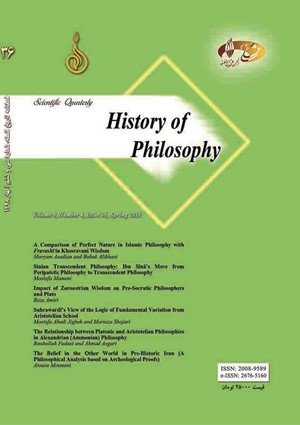The Belief in the Other World in Pre-Historic Iran (A Philosophical Analysis based on Archeological Proofs)
Subject Areas : Connection of philosophers’ views and philosophical schools with the social and philosophical conditions of the time
1 -
Abstract :
Following the growth of human sciences, archeology, as one of the materialist and spiritual branches of human sciences, has recently been seeking to learn about the quality of the formation, continuity, and change of early societies. It has been doing so on the basis of tangible and intangible proofs and through investigating the development of thoughts, cultures, traditions, and beliefs of such societies. Moreover, archeologists aim to perceive this process of change and development alongside rational and logical findings in relation to human worldviews as an everlasting treasure which has lingered since pre-history until now. Death and its life-related and ontological dimensions in different cultures and societies have always been among the most fundamental problems attracting the attention of human beings all over the world. In fact, humans are essentially living beings who are always thinking about death and have continually kept their connection with this concept in the course of history. Archeological proofs represent the most tangible legacy of death-related thoughts and demonstrate people’s attention and sensitivity to death, which are themselves rooted in their philosophy of the other world. In the present paper, the author has tried to deal with the philosophy of death and Man’s thanatoptic nature during the second and first millennia BC based on some archeological diggings in an Iron Age cemetery (which represents a specific age and a region with a rich ancient history and culture). She has also sought to particularly study burial traditions and their changes along with their underlying ideological foundations. In this way, with references to certain archeological studies and discovered artifacts in field excavations, the author hopes to shed some light on Man’s awareness of death and their beliefs in relation to the world after death and analyze the transfer of such thoughts and all their evolving dimensions to the next generations based on rational and logical principles.
تیواری، کدارنات (1396)، دینشناسی تطبیقی، ترجمه مرضیه شنکایی، تهران: انتشارات سمت، چاپ3.
جهانی، ولی (1393) باستانشناسي دیلمان، رشت: نشر بلور.
حاجتی شورکی، سیدمحمد؛ فاریاب، محمد حسین (1396) «بررسی تطبیقی سرنوشت انسان پس از مرگ در دین زرتشت و اسلام»، مجله معرفت ادیان، سال 8، شماره 2، پیاپی30، ص53 ـ 74.
حکیمی، محمدرضا (1388) معاد جسمانی در حکمت متعالیه، قم: انتشارات دلیل ما، چاپ 7.
خامنه¬ای، سیدمحمد (1397) تاریخ جامع فلسفه (مقدمه)، تهران: بنیاد حکمت اسلامی صدرا، چاپ 1.
خدادادیان، اردشیر، (1376) آریاییها و مادها، تهران: اصالت تنشیر.
خلعتبري، محمدرضا (1383) كاوشهاي باستان¬شناسي در محوطه¬هاي باستاني تالش (وسكه و ميانرود) تهران: انتشارات پژوهشگاه سازمان میراث فرهنگی، صنایع دستی و گردشگری.
طلایی، حسن (1381) «سنتها و شیوه¬های تدفین در عصر آهن ایران (حدود 800-1450 ق.م)»، مجله دانشکده ادبیات و علوم انسانی دانشگاه تهران .
طلایی، حسن (1387) عصر آهن ایران، تهران: انتشارات سمت.
عليزاده، عباس (1380) تئوري و عمل در باستان¬شناسي، تهران: انتشارات پژوهشگاه سازمان میراثفرهنگی، صنایع دستی و گردشگری.
كامبخشفرد، سيفالله (1370) تهران 3200 ساله بر اساس يافتههاي باستانشناسي، تهران: نشر فضا.
كامبخشفرد، سيفالله (1379) سفال و سفالگري در ايران از ابتداي نوسنگي تا دوران معاصر، تهران: نشر ققنوس.
مؤمنی، آتوسا (1388) بررسیهای باستانشناسي دره تاریخی اندج رود، آرشیو پژوهشگاه سازمان میراث فرهنگی صنایع دستی و گردشگری.
نگهبان، عزتالله (1378) حفاريهاي مالريك، تهران: سازمان ميراث فرهنگي جلد1.
وحدتی¬نسب، حامد (1393) «انسان نئاندرتال: مرگ و مرگ آگاهی»، پژوهشهای انسان¬شناسی ایران، دوره4، شماره1.
Binford, L. R., and Binford, R., (1968) New Persectives in Archaeology, Chicago.
Brown, J.A., (1981) the Scarch for Rank in Prehistorric Burials, Cambrige.
Chapman, R., Kinness, I., and Randsborg, K., (eds.) (1981) The Archaeology of Death, Cambridge
Moemeni, A., (2014) PHD Desertation, Tajikestan Academy of Science Arshive.
Piggott, S., (1973) Problems in the Interpretion of Chambered Tombs, Daniel, g., and Kjaerum (eds), (1969) Megalithic Grave and Ritual, III, Atlantic Colloquium Moesgard.
Renfrew, C., and Ezar B. E., Zubrow (eds.) (1994) The Ancient Mind, Elements of Cognitive Archaeology, Combridge.
Talai, H., (1999) “Funeral Rite at Zagheh: a Neolithic Site the Qazvin plan”, Documenta Praehistorica, vol XXVI, www.dlib.si.


